Written by Rajesh Kamath
Benares
Mohanji was invited to Benares (aka Varanasi) by the spiritual head of a 90+ year old spiritual tradition which is spread all over India and across 35 nations in the world. Their founder, who discovered meditation techniques after decades of strenuous and intense spiritual practices, established the tradition in the early 1900s. He also conceived the spiritual essence in a high state of realization and authored a philosophical treatise based on these experiences. The meditation techniques and the philosophical treatise comprise the core for their teachings. The lineage of the Gurus of this tradition extends from the founder to the current Acharya Parivar (family of spiritual preceptors). The Acharya Parivar comprises the spiritual head (henceforth referred to as Guruji), his wife and his two sons who propagate the tradition and guide spiritual seekers in India and across the world.
A brief background as usual. 🙂 Benares happens to be one of my favorite cities in India. It has always felt like home to me. It is a very busy city with tiny roads teeming with people at all times of the day and night. The city tends to be crowded and dirty but, in my opinion, it is a facade to turn away the casual tourists who are unaware of its spiritual significance. This is the city that has been blessed by the presence of spiritual giants like Lahiri Mahasaya (the modern founder of the Kriya Yoga tradition mentioned in the Autobiography of a Yogi by Paramahansa Yogananda), Trailanga Swamy (again referred in the Autobiography), Goswami Tulsidas (the poet saint who wrote the Hanuman Chalisa – the famous ode to Lord Hanuman – the eternal devotee), Sant Kabir Das (the famous weaver saint and poet) and Saint Ravidas (the guru of Meerabai – the famous poetess and devotee of Lord Krishna) amongst others. Not to mention spiritual masters of yore. The ghats (bathing platforms) on the banks of the river Ganges are very serene. The beautiful Ganga aarati (ritual worship of the Mother Ganga) performed every evening is a picturesque spectacle to behold. Every nook and corner of this city is saturated with spiritual grace. You need to experience the spiritual energy of this city to believe it.
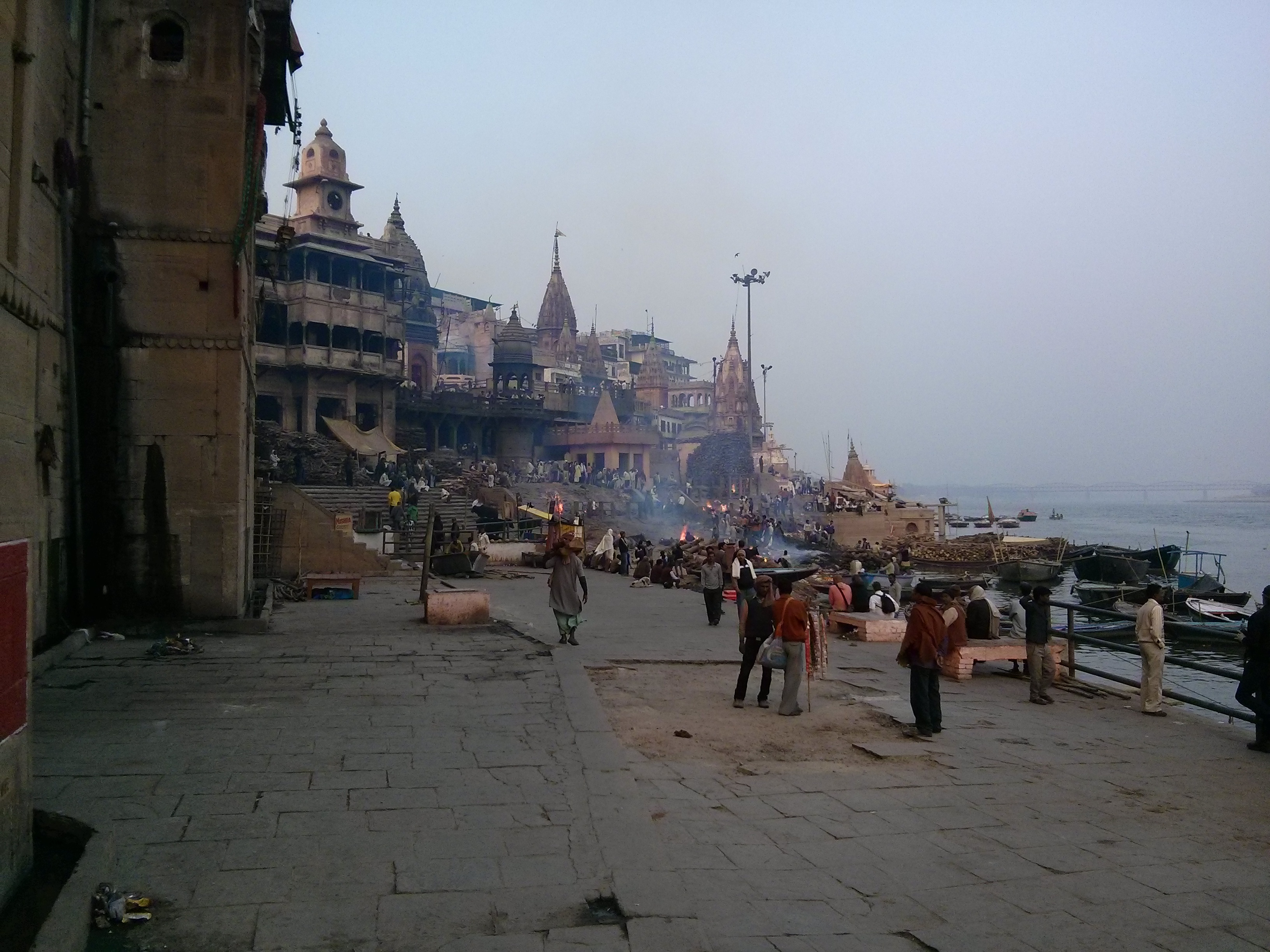
Mohanji was not keeping well at that time due to the constant travelling plus the other reasons mentioned in the earlier parts of this blog post. Hence, he was suggested by many of us to avoid undertaking this trip to Benares. Mohanji told us that Guruji was coming down to Benares from Kolkata especially for Mohanji. Guruji had also reserved time for almost a week to be with Mohanji because he had a special love for Mohanji. Mohanji said that he never likes to let people down. He was categorical that he always likes to keep his commitments as best as he can. Hence, he decided to go ahead with his planned trip despite objections from all around.
We had packed our bags late last night with the able assistance of Preeti didi (sister). Amongst all the commotion last night, we ended sleeping very late into the night. But we had to wake up early in the morning since we had an early morning flight. Raman sir and his group joined us for breakfast. Mohanji and Raman sir had their discussion mostly in Malayalam. Raman sir and his group were scheduled to leave in the afternoon to continue on their onward journey. Once we finished breakfast, it was time for us to leave. Mohanji and Raman sir embraced each other with a lot of love and affection. I prostrated at both their feet and took their blessings. Us groupies also said our goodbyes and hugged each other.
Mohanji and I then set out for the airport. At the airport, we checked in and moved towards our gates. When I offered to carry his cabin bag, Mohanji said, “Everyone has to carry his or her own karma. I will carry mine”. The import of this statement was not lost on me particularly coming from my Guru who is helping me with most of my karmic baggage. And I am already reeling under the weight of the bare minimum that he has left for me. 🙂 After a short wait at the airport, we boarded our flight. The flight had a short layover at Delhi before continuing on to Benares. By late afternoon, we reached Benares. Mohanji’s personal assistant, Sandeep Mishra and his wife (Slavica) had flown in directly from the Dharamshala ashram to join us in Benares. There was also a group from our host (Manik Jain and Shastriji) to welcome Mohanji. Manikji had been coordinating with Mohanji on behalf of our host. Mohanji left in a car with Mishraji and Slavica while I went in the other car with Manikji and Shastriji. As we were getting into our respective cars, Mohanji made a curious statement that Manikji was his classmate from another lifetime and asked me to check with Manikji to find out what that meant.
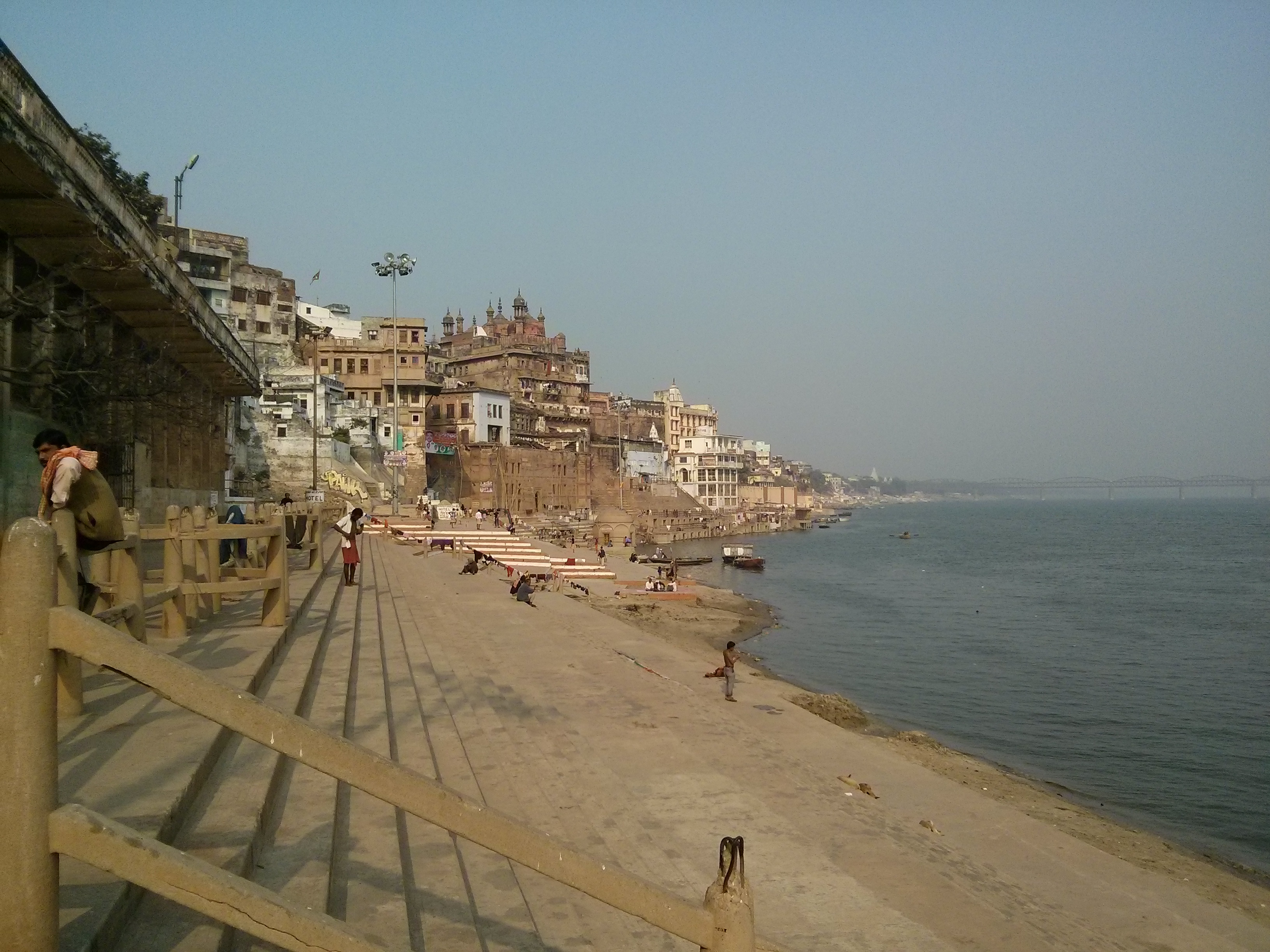
As we were driving to the ashram in Benares, I was curious about the statement that Mohanji made and asked Manikji about it. Manikji said that he and Mohanji were guru-bhais (brother disciples of a Guru) in a previous lifetime. Their Guru in that lifetime was the founder of the spiritual tradition that had invited Mohanji to Benares. In that lifetime, Mohanji continued doing intense sadhana (spiritual practice) and tapas (penance) as a monk while Manikji subsequently moved onto a more terrestrial life. Manikji said that Mohanji, in that lifetime, used to shun the public gaze and stay in isolation but Manikji would seek him out from his various seclusion hideouts. He would try to get Mohanji to stay at his place and serve him. Invariably, a crowd would gather in wait of Mohanji at his place and Mohanji would, at the sight of the crowd, disappear soon after. And so his hunt would continue afresh. 🙂 In this lifetime, Manikji said that he had been blessed with spiritual tendencies and siddhis (spiritual powers) since childhood. He had visions and visitations from his erstwhile Guru (the founder of the spiritual tradition) since childhood and he had subsequently become a devoted follower of Guruji who was his Guru in this lifetime. Even in this lifetime, he had a strong recollection that his guru-bhai, Mohanji, had also taken birth and he had been actively looking out for Mohanji. Through a mysterious set of circumstances, he finally got connected to Mohanji first over the phone and then in person at a hotel in Mumbai.
Subsequently, he met Mohanji twice alongwith the entire Acharya Parivar – once at Mohanji’s residence in Oman and then at the Kumbh mela. He told me that Mohanji was highly evolved spiritually. According to him, a proof attesting to that fact was that the entire Acharya Parivar had dinner at his residence in Oman. He said that the Archarya Parivar has not done this for anyone before or ever since. The Acharya Parivar meeting someone together is in itself a big thing but their partaking of food at someone else’s residence is something he has never seen them do for anyone else. Shastriji also concurred. Manikji also mentioned that Guruji had initiated Mohanji into advanced levels of their spiritual tradition something that would have been possible for the adherents in their tradition only after many years of diligent practice. He also mentioned that Guruji (and also his son) had specially taken time out of their extremely busy schedule to meet Mohanji personally. Manikji said that this was testimony to the high regard in which Guruji held Mohanji. He also extolled Guruji by mentioning several anecdotes that testified to his different siddhis (spiritual powers).
I was slightly dejected when I found out that the ashram where we were headed was not in the city of Benares but located on the outskirts far from the city. The journey was in a primarily rural setting with fields and greenery on both sides intermittently dotted with rows of small shops and houses. Cows were grazing lazily on the roadside while small groups of people went about their daily activities. There were the ubiquitous dogs in various states of action and inaction. We soon passed by the city of Benares leaving behind a small twinge of sadness in me. We soon reached Sarnath – the city forever hallowed by the presence of the Great Gautama Buddha and fortunate to be the setting of his first sermon after attaining enlightenment thus bringing the Buddhist Sangha (community) into existence. It is one of the four important pilgrimage sites in the Buddhist tradition as designated by Gautam Buddha. You can see the temples and monasteries from every country that has a significant Buddhist tradition – Japan, Thailand, Tibet, Sri Lanka and Myanmar amongst others. The place is dotted with Oriental flags and signboards in most Asian languages. As we passed through Sarnath, we saw the ruins of the stupas – once impressive monuments from a bygone era that are now in a state of ruin. In particular, we passed by the massive Dhamek stupa that marks the spot of a deer park (Rishipattana) where the Buddha gave the first sermon to his five disciples after attaining enlightenment,
After Sarnath, my interest in checking out the surrounding scenery was rapidly waning. Cows, dogs, trees and people look surprisingly similar and uninteresting to one with a hungry stomach. It was more than 8 hours since I had seen proper food (the measly sandwich on the flight does not count). I kept pestering Shastriji on the time to the destination. He kept responding with time estimates that obviously corresponded to a different time frequency where time waxes in ultra slow motion. After an excruciatingly long time, we finally reached the ashram. We passed the beautiful mega temple along the road adjoining the ashram and it was a sight to behold. It had not been fully constructed yet but it was a beautiful imposing structure built like a lotus with its petals stretched out at each storey of the building. Manikji told us that this mega temple was the magnum opus of their organization. He told us that visiting this beautiful place was part of our itinerary. So my mind quickly filed it away in a remote mental to-do list while retaining it’s focus on hunger.
We were taken to the VIP guesthouse close to the mega temple. The VIP guesthouse was a tall white building (at least tall for these parts) part of which was still under construction in front of a huge vacant space in front of the building with fields in front of the vacant space and a gaushala (cow shelter) towards the right. The vacant space was littered with bamboo sticks, carpets and roofing material. Manikji informed us that they had a huge gathering there recently with tens of thousands in attendance and these were the remnants of the makeshift arrangements made for that gathering. Farms surrounded the place on all sides creating a beautiful rustic village setting.
On reaching the guesthouse, Shastriji quickly swung into action and got us and our luggage into our respective rooms. The rooms were modern and tastefully done. The staff at the guesthouse was attentive to our every need. They came in to check if our rooms were fine in all aspects and kept chiming in at frequent intervals to find out if they could do anything to make our stay better. Shastriji mentioned that he was actually the administrative in-charge of their ashram in Sarnath. But Guruji had put him personally in charge of our welfare for the duration of our visit. He said that his single point objective was to ensure that Mohanji and, by extension, our group were taken care of in the best manner possible. He said that Guruji himself had called in yesterday to ensure that all the necessary arrangements were made for us and Guruji was constantly following up with him on a regular basis. The staff seemed awed by our presence because of the honor Guruji was bestowing on an unassuming Mohanji and our group.
Finally after a long long long wait, we stepped into the dining area for lunch. It was a veritable feast and the wait was well worth it. Did I mention that the lunch was sumptuous and delicious? 🙂 The staff was literally at our beck and call and they ensured that our every need was taken care of.
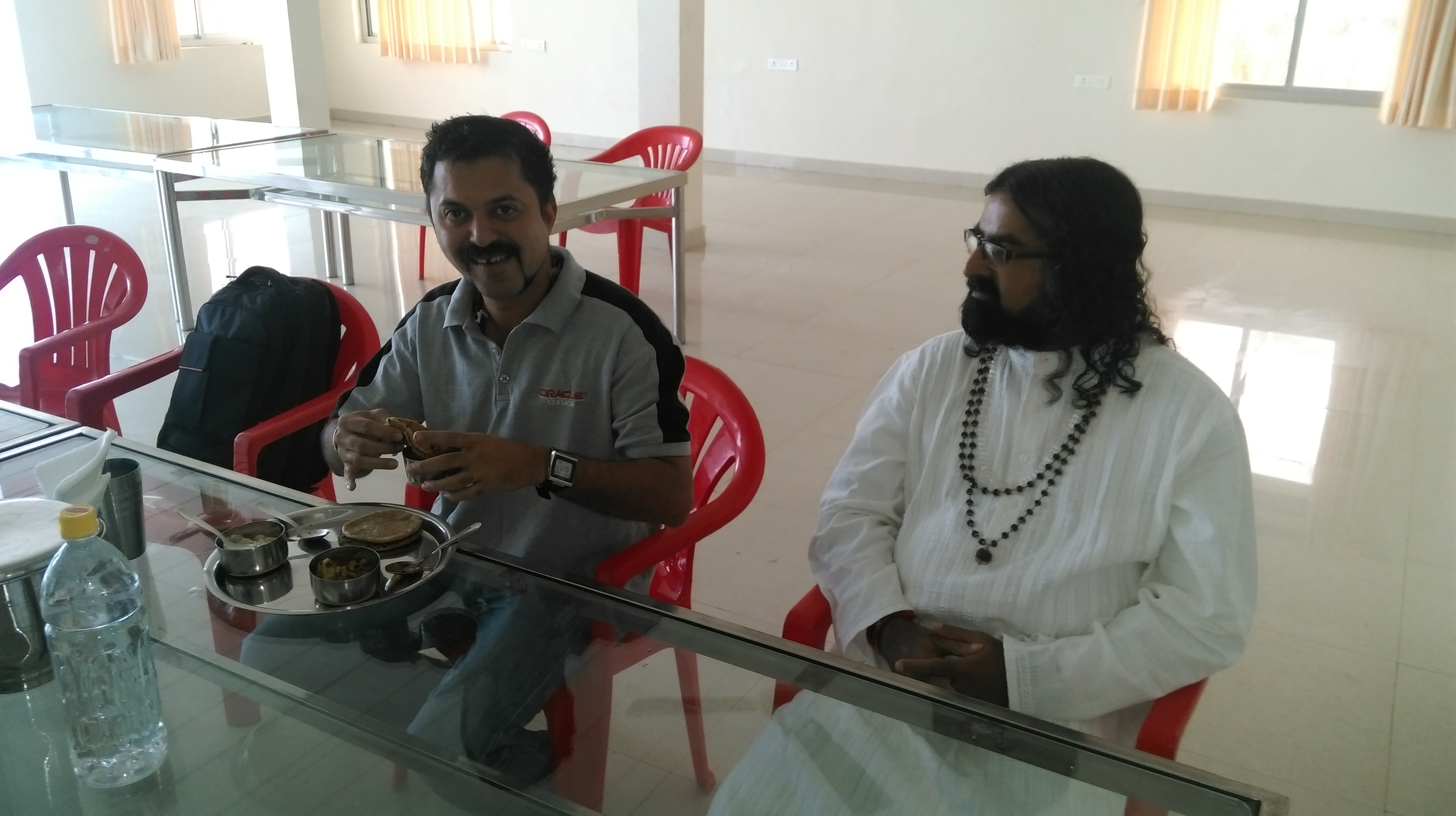
We were told that there was no plan for the day except for Guruji’s son visiting Mohanji later in the day. Manikji told me that Guruji’s son (also part of the Acharya Parivar) was a spiritual adept right from birth and a great yogi. He had been specifically invited from the astral planes to take birth on earth to assist Guruji in his mission. He said that being in his presence was life transforming. Manikji was super excited that Guruji’s son was going to come down to the guesthouse and was really looking forward to it. Manikji opined that the Acharya Parivar appreciates Mohanji’s purity as well as his deep humility. Until evening, we just chilled in our rooms and around Mohanji.
In the evening, Guruji’s son came to meet Mohanji. He checked with the staff and Shastriji first to ensure that everything was being taken care of. We found out that Guruji had also called Shastriji to enquire about our comfort and welfare. Guruji’s son was then led to Mohanji’s room. He was very courteous and humble. He enquired about our comforts and asked us to let Shastriji know if we needed anything. They exchanged pleasantries at which point Mohanji asked our group to leave them alone for a discussion. They had a long discussion until dinner. We served their dinner in Mohanji’s room. They continued their discussion post dinner after which Guruji’s son took Mohanji’s leave.
The next day we headed out to their main ashram in Sarnath to meet Guruji. We had our breakfast and Shastriji got the vehicles ready at the appointed hour. As we made our way to the ashram, Mohanji asked us to get fruits and flowers for the occasion. We picked up the fruits and flowers and reached the ashram. The ashram has a view to the river Ganges and is surrounded by marshes and farmland on one side. It has a beautiful view and the surrounding area is untouched for the most part. We were taken towards the building where Guruji was supposed to meet us. There was a temple adjoining the building. Mohanji ventured in and found it to be a temple of the founder of the spiritual tradition. He paid his respects and prostrated in front of the statue.
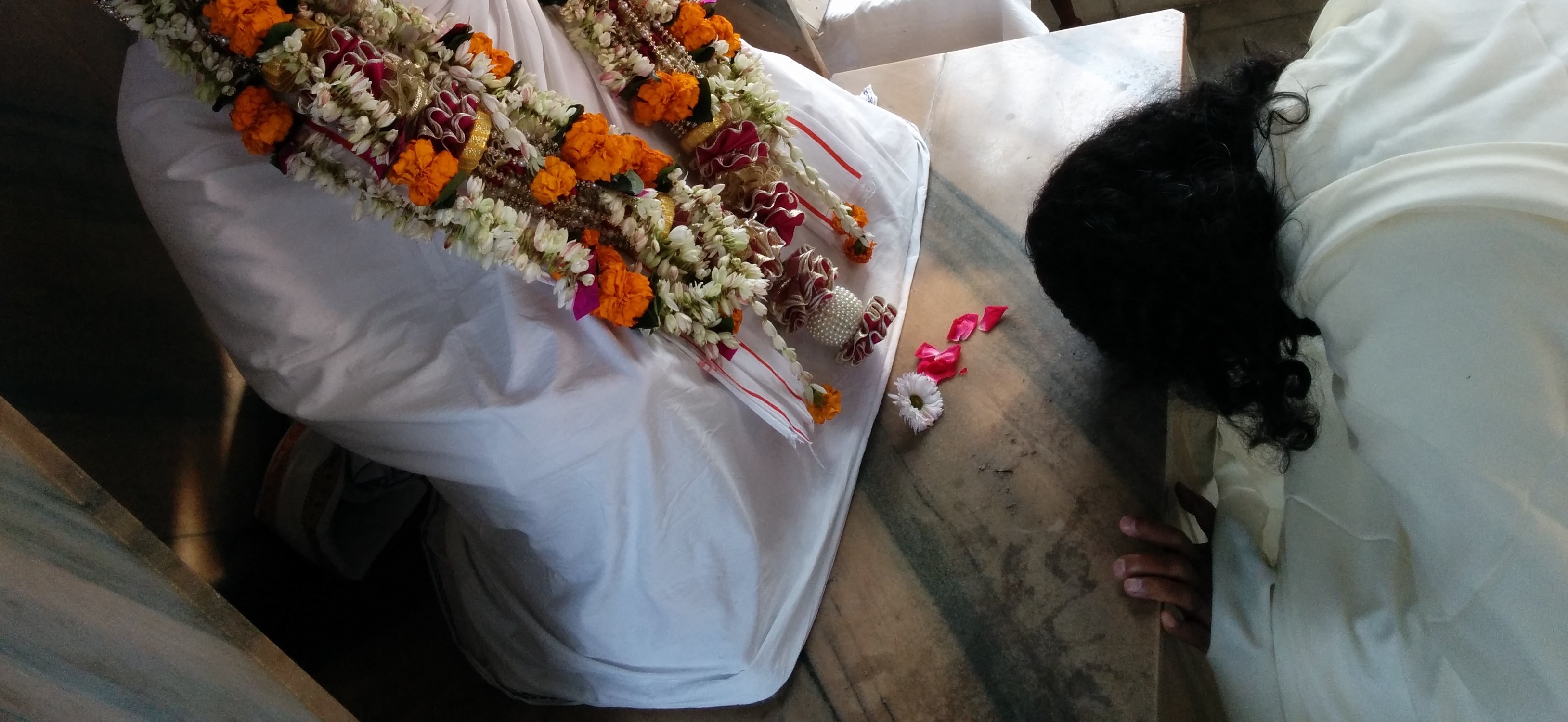
We then went to the assigned meeting room. Mohanji noticed that the sofa and the carpet on the ground were soiled and it did not seem appropriate. He asked us to get white sheets to cover the sofa and the carpet. He also asked us to get a fruit bowl and some plates for the flowers. It was interesting to see that Mohanji had his eye on every detail. Normally, we should have noticed this and acted upon it. Sometimes, awareness is all it takes. Easier said than done, though. We scrambled around and got hold of the staff in the ashram and managed to get the required stuff. We draped the white sheet on the sofa and spread the other white sheets on the floor. We arranged the fruits and flowers tastefully and readied ourselves for Guruji.
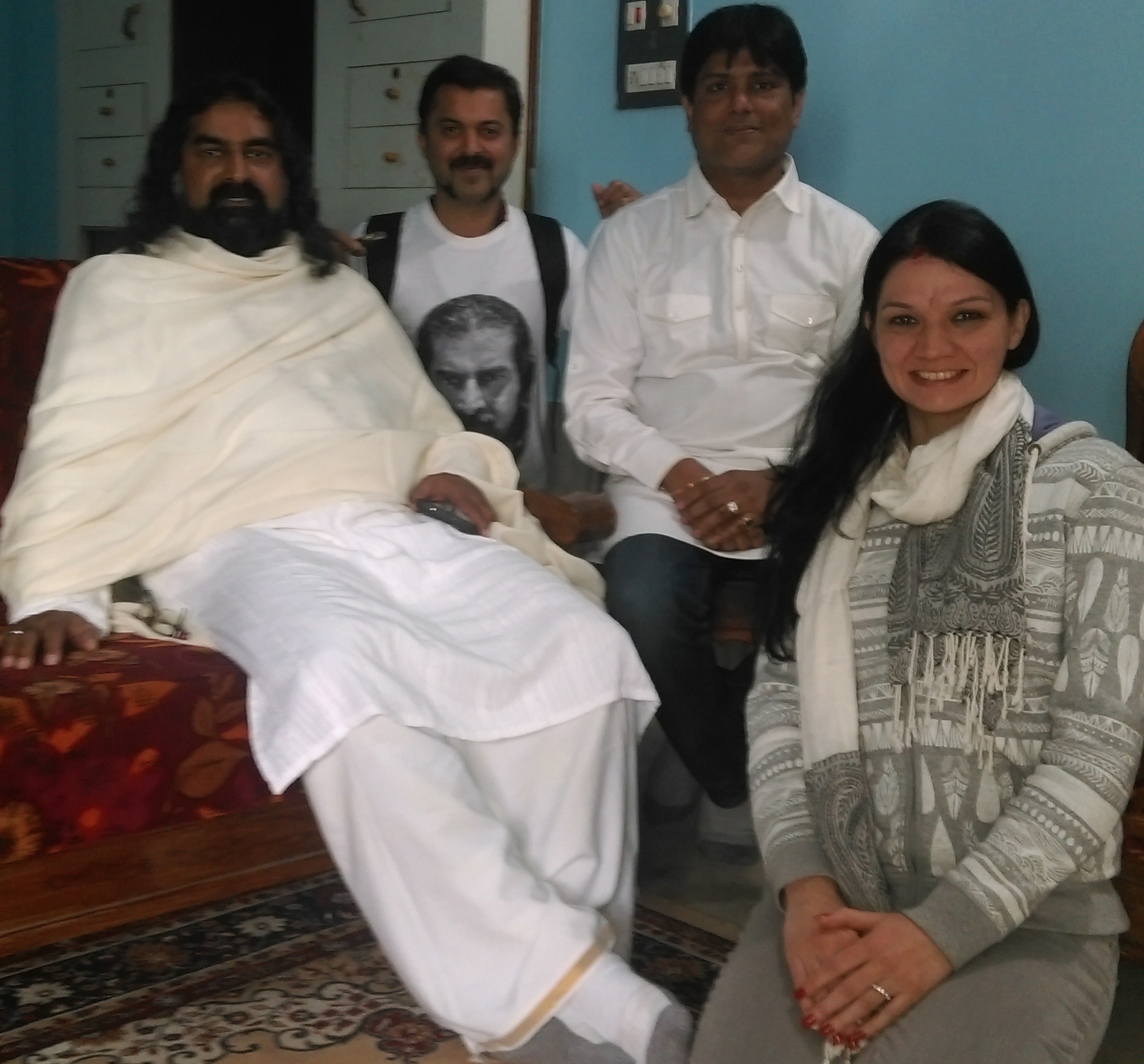
After a while, Guruji came to the meeting room. Mohanji garlanded him and prostrated at his feet and he hugged Mohanji. Manik told us later that Guruji never hugs people. He was really surprised at the gesture. Mohanji offered him the flowers and fruits. All of us prostrated in front of him and took his blessings. We were then asked to leave with the exception of Manikji. We were led by Shastriji to an adjoining guest room building and given rooms to hang around. The meeting lasted a long time. We were killing time in the guest rooms. They kept serving tea and coffee to keep us occupied. I took to chanting to pass the time. Intermittently, I would check out the marshy fields bordering the ashram from the verandah. Children were scampering around and playing around the marshy waters while farmers went about their regular duties. Eventually after a very long wait, the meeting got over. Guruji personally came out to drop Mohanji to his car. Manikji told us that Guruji does not come out to drop even dignitaries – ministers, politicians or industrialists – no matter how important and powerful they are. He told us that the sign of respect offered by Guruji was a sign of Mohanji’s purity and spiritual stature. We then headed back to our rooms in the guesthouse.
Rathodji who was a close friend of Manikji soon joined us. Rathodji was a cute chubby personality who is “well rounded” from all sides. 🙂 The cold was affecting him a lot so he chose to stay wrapped in quilts most of the time making him look like a veritable teddy bear. He was in the business of registering charitable trusts that, according to him, were setup mostly by religious/spiritual organizations and politicians. He regaled us with a lot of stories based on his quirky experiences with both. His other pastime was to be pictured up close and personal with spiritual personalities and politicians. 🙂
In the evening, we visited the mega temple. Guruji and his son came along to give us a tour of the place. The temple is a huge seven-storeyed temple that can house 20000+ people and was being built at a cost of a billion rupees (around $20 million). All around the pillars of the temple, the verses of their lineage founder’s philosophical treatise are carved on premium marble. Each floor in the temple corresponded to a level in the spiritual path of their tradition. As we walked past the temple entrance, they took us to the machining area where the latest machines were being used to inscribe the text on the marble. The engineer in charge walked us through the whole process and gave a demonstration of how it was done. Then we walked floor by floor all the way to the top. Guruji gave us a brief on each section of the temple and the thought process behind the construction. Manikji told us that Guruji himself had conceived the entire design for the temple. The size and scale of the temple invoked a sense of awe. The temple was very beautiful and a lot of detailing had gone into its construction.
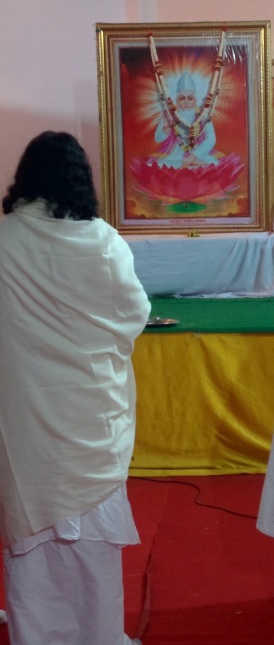
Post the temple tour, we headed to a section in the temple premises that served as an office and resting area for the Acharya Parivar. Mohanji was led by the Guru and his son and seated with them. Our group followed in as well. They had a general discussion. Mohanji suggested that he would like to visit the Ganga ghats the next day. Guruji’s son said that he would personally escort Mohanji and our group. Mohanji said it wasn’t necessary since Mohanji didn’t want to disturb his schedule. But Guruji’s son insisted on it. After some time we headed back to the guesthouse. Manikji was surprised that Guruji’s son offered to escort Mohanji around Varanasi. In this experience, it was the first time that he was doing that for anyone. By now, even Manikji was nonplussed by the inordinate affection and respect shown to Mohanji by the Acharya Parivar.
The morning of the next day, Rathodji told us that he had the attar (fragrance) that is used on the statue of Sai Baba in the Samadhi mandir at Shirdi when it is adorned before the aarati (ritual worship). He generally does not give it to anyone but he had a strong desire to give it to Mohanji. He said that he also had the red kumkum (red pigment applied on the forehead of women) that was used to anoint the Divine Mother at Saptashrungi Mata mandir, a powerful Shakti Peetha (power centers of the Divine Mother). He wanted to offer that to Mohanji as well. He requested us to speak to Mohanji on his behalf and check with him if he would accept the offering. We went up to Mohanji and relayed Rathodji’s request to him. Mohanji immediately agreed to accept it with love considering it to be the blessings of Sai Baba. Right around the time Rathodji gave him the attar and the kumkum, Shailaja Maa (mother), the granddaughter of Laxmi Bai Shinde, called Mohanji as if on cue.
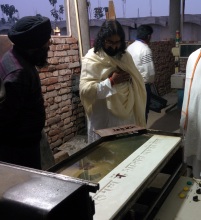
Laxmi Bai Shinde (fondly called by Sai Baba as Laxmi Maa) was a close devotee and disciple of Sai Baba. For forty years, she used to first feed Sai Baba and only then have her food. Just before his samadhi (conscious exit of the soul from the physical body accomplished by yogis when their time has come), Sai Baba gave Laxmi Maa nine coins signifying Navavidha Bhakti (the nine forms of devotion) for her love and wholehearted service and care. These nine coins are now in possession of Shailaja Maa who is also a true Sai devotee. These nine coins are on display in Shirdi and she (or her family) frequently travels with it to different parts of India and the world.
Shailaja Maa loves Mohanji like her son. She enquired about Mohanji and asked him about his health, family and travels. She told him that it had been a while since he had visited her in Shirdi. She told him to remember that he had a home in Shirdi whenever he chose to visit. The call from Shailaja Maa happening at the same time was like a sign from Sai Baba that the attar and kumkum were being sent to Mohanji at his behest.
After breakfast, Guruji’s son came down to the guesthouse. We immediately drove off towards the bathing ghats adjoining the river Ganga. Since the roads leading into the ghats are cordoned off for security reasons, we got out of our cars and walked on foot to the ghats. Guruji’s son and their group led the way and quickly guided us to the main Dashashwamedh ghat. We walked through the steps of the ghat and located a place adjoining the river where we decided to take our dips. Mohanji was feeling unwell and, hence, decided not to enter the cold water to avoid any ill effects on his health. He wet his feet and offered his prayers from outside. Sandeep and I got into the water. We did Mohanji’s paad abhishekam (ritual bathing of the feet) with water from the holy Ganga river. We bought packets of puffed rice and offered it to the sea gulls. An entire swarm of sea gulls showed up and splashed around the water to partake of it. They were crowded all around us and made for a very pleasing sight. We also bought all the lamps from a kid who was selling them near our bathing spot. We lit them on behalf of everybody and offered them to Mother Ganga by setting these lamps afloat on the river. We offered our prayers and offerings to the Mother Ganga and then proceeded to take our dips in the holy river.

During the Kailash trip, Mohanji had explained the process of taking dips in a holy river. He had said that your entire body including the head and back should be completely submerged to count as one dip. The first dip is for self, the second is for one’s parents/ancestors and the third is for your Guru. After three dips, one can continue to take dips on behalf of anyone else like friends or family, a beloved deity, an ascended master, etc. When I was about to take the dips, it occurred to me that Mohanji is a representation of everyone – self, ancestors, friends & family, ascended masters, etc. So I decided to take 108 dips for Mohanji. I was overcome with a strong emotion as I took the dips. It was a beautiful experience for me. When we were done with our dips, we offered our prayers to the mother Ganga again and then came out of the water. We dried ourselves, had a change of clothes and then headed out of the ghats. Later, Mohanji asked me about my dips. I told him about the 108 dips I took on his behalf. He smiled and said he knew about it because while I was taking the dips, water from the Ganga appeared from under his feet and wet his socks. 🙂
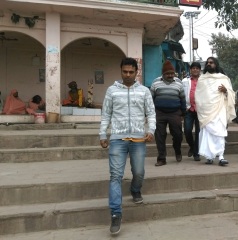
From there, we quickly retraced our steps back to our waiting vehicles and headed to the Kashi Vishwanath temple – a form of Lord Shiva who is the presiding lord of Benares). Kashi Vishwanath is one of the twelve Jyotirlingas (Lord Siva in the form of light) that are considered to be the holiest of Siva temples. The temple is an important place of worship for Hindus and great saints like Adi Sankaracharya (the glorious master who unified and re-established modern Hinduism), Ramakrishna Paramhansa (the powerful mystic and lover of the Divine Mother), Swami Vivekananda (the master who was the first to take Hinduism to the West), Goswami Tulsidas (the poet saint who wrote the Hanuman Chalisa – the famous ode to Lord Hanuman – the eternal devotee), Swami Dayananda Saraswati (the founder of the Arya Samaj – a Hindu reform movement of the Vedic tradition) and Guru Nanak (the founder of the Sikh religion) have visited the temple. It is believed that a visit to the temple and a bath in the river Ganga leads one to liberation.
The access to the temple complex of Kashi Vishwanath is via designated gates for entry and exit with small lanes leading to these gates. These lanes are barricaded by the police and there are multiple checkpoints along the way with security checks all along that slow down movement considerably especially when it is crowded. Except for the offerings, no electronic equipment including mobile phones and cameras is allowed in the temple. The lanes are dotted with small shops that sell various offerings for the Lord and let you leave your footwear, mobile phones and cameras in return (footwear are not allowed within Hindu temples). All of us walked through the busy by-lanes and headed through the entrance gates of the temple. After various checks and stops, we finally made it inside the gate and got into the queue to get into the sanctum sanctorum. The security staff wanted to see Slavica’s passport (which she wasn’t carrying) so she couldn’t get inside the gates. Guruji’s son graciously asked us to continue on and offered to discuss with the security staff to resolve the issue.
Soon we were surrounded by a crowd getting ready to enter the temple with a lot of jostling and pushing by devotees eager to get the sight of the Lord. Sandeep Mishra and I formed a “wall” around Mohanji to ensure that he didn’t get pushed around. There was a man behind Mohanji who sided up to him and got up close. He was a rustic man wearing a red kurta over a white dhoti with a very colorful multi-layered turban that is generally worn in the desert regions like Rajasthan and Gujarat. He was tall and rugged and his face was pockmarked. There was something odd about his persona. He looked very different from the rest of the people around us plus his attire made him stand out as well. He had a ghostly and martial aura around him and sported a deadpan look. Sandeep Mishra quickly closed in and asked him to stop pushing and back off. He had an aghast expression on his face – which was out of context and hence almost comical – as he replied, “I am not pushing. How can I think of pushing the Lord? I am also here to protect my Bholenaath (another name for Lord Shiva – translates to the Innocent Lord)”. He then smiled a toothy grin. Mohanji looked back at him and smiled. He had a loving look on his face as he looked at Mohanji and gently rested his chin on Mohanji’s shoulder. Mohanji patted him on his cheeks with a lot of love. The man then gently tilted his head and nudged it towards Mohanji’s head. We were watching this whole scene with a lot of amusement. It was very touching and we knew he was no ordinary person. The man then looked at us and said in Hindi, “Look at my good fortune! Bhole Baba (another name for Lord Shiva – translates to the Innocent Father) himself is taking me to his temple for darshan (the holy sight of the deity)”. We were perplexed at this strange comment.
Suddenly, there was a lot of commotion as the doors to the sanctum sanctorum were opened. We immediately swung into action. The good thing about temple crowds in India is that you don’t have to make your way towards the idol. You just need to orient yourself at periodic intervals to ensure that you are not pushed out or back and the crowd ensures that you reach the destination. 🙂 Amidst all the elbowing and pushing that began, we made our way into the sanctum sanctorum. We tried our best to shield Mohanji from the milling and enthusiastic crowds anxious for darshan. Shouts of “Bhole Baba ki Jai” (Hail the Innocent Father) and “Kashi Vishwanath Maharaj ki Jai” (Hail Shiva, the Lord of Kashi) rent the air. We were shoved into the sanctum sanctorum and gradually found ourselves near the Shiva Lingam (the idol representation of Lord Shiva). The Shiva Lingam was encased within small walls (probably meant for protecting the idol from the masses) so you had to bow down from a distance and reach forward to touch the idol. Some priests were performing abhishekams (ritual bathing) and pujas of the idol with and for the devotees. We dodged past them and finally reached the Shiva Lingam. Mohanji reached down, touched the Shiva Lingam, offered his prayers and moved on to exit the sanctum sanctorum. We also quickly offered our prayers and followed him out.
Through all the commotion, we forgot all about the man standing behind Mohanji. When we got out, the interesting thing was that the man was nowhere to be seen. Mohanji smiled and asked us to look around for him. We searched for him but we couldn’t locate him. When we asked Mohanji who he was, Mohanji smiled and replied that he “could be” Nandi. Amazing, Lord Nandi himself! 🙂 For worshippers of Lord Shiva, Nandi is synonymous with Lord Shiva. Nandi is the white bull that is the vehicle of Lord Shiva and the chief of the Siva Ganas (the army of Lord Shiva). In addition to being his vehicle and General, Nandi is considered to be the foremost disciple of Lord Shiva. It is said that Nandi was a handsome bloke but he took the form of a bull so that he would not entice anyone who could possibly get in the way of Nandi’s devotion to Lord Shiva and he would not take any attention away from Lord Shiva. When the ocean was churned, a dangerous poison was produced that was capable of dragging even the devas (demigods) to the realms of human suffering and ego. None were capable to counteract it except Lord Shiva who drank all of it. When some poison spilled out of Lord Shiva’s mouth, Nandi quickly drank it off the ground. The devas (demigods) were horrified and wondered about Nandi’s fate. Lord Siva calmed them and said, “Nandi has all my powers and my protection since he is completely surrendered to me”. Such was the extent of his devotion! Most Shiva temples have stone images of Nandi facing the main shrine honoring this fact. Given our lean frames, our “wall” around Mohanji needed a third person to complete it. And Lord Nandi came in to complete the triangle. How cool is that? This also begs the question – in the sweet name of God, who the heck is Mohanji? 🙂
In retrospect, it makes me wonder. I came in from a tangible world where people, places, objects and situations where what they seemed to be. The scriptures say it is all a grand illusion but it made complete sense to me. They say it is false but it looked “real” to me. Now with Mohanji, I am suddenly introduced to a world where everything is suspect. Nothing is what it seems to be. I was lamenting to a close follower of Mohanji that my world has suddenly gone topsy turvy after being with Mohanji – from the “real” to the “surreal”. 🙂 There is a saying in Marathi, “Dista tasa nasta ithech jag fasta” (Everything is not what it seems, hence the world gets fooled). Trees, animals, humans – you are never sure who is lurking in front of you. It is unsettling to say the least. When you look at something, you wonder – is there a holy personage hiding in the form in front of you? Sai Baba wanted his followers to see Him in all beings. With a few episodes like this happening to me, I have suddenly started to venture down that path if not out of understanding then at least out of curiosity. 🙂
Moving on… The exit for the sanctum sanctorum leads to a prayer hall where the priests were conducting abhishekams and pujas for the devotees. To the right of the prayer hall, there is an enclosed seating area for the priests where some of them were chanting in unison on behalf of the devotees. There are several small temples of various deities adjoining the main temple within the temple complex. We moved to the different temples and offered our prayers and then returned back to the prayer hall. We were waiting for Slavica and Guruji’s son to come down. Mohanji asked us to go back into the sanctum sanctorum and get a few malas consecrated by directly touching them to the idol. This is not allowed in the Kashi Vishwanath temple. Sandeep and I mentally said a few prayers and headed back into the sanctum sanctorum. We held the malas surreptitiously in our hands and quickly touched them to the idol and scampered out. Nobody seemed to notice so it worked out well for us. 🙂
Sometime later, Guruji’s son and Slavica came down. He got the issue sorted out with the security and both of them had their darshans. Once they joined us, Mohanji decided to do an abhishekam for the Lord in the prayer hall. We located a priest who quickly came down and offered to conduct it. All of us sat around Mohanji and the priest as the priest started to conduct the ritual. He started chanting mantras and making offerings of milk, honey, sugar, holy water, etc to the Shiva Lingam. Finally, when the priest was done, we offered him the agreed upon dakshina (the donation to the priest for conducting the ritual). But the priest started demanding more from us as dakshina. Mohanji chided him saying, “You are a Brahmin. You should not be greedy. The Lord provides for you. It is a noble service to do His duty. Don’t try to fleece devotees. It is unbecoming of your profession”. He was visibly flabbergasted and apologized. Mohanji asked us to offer him some more money.
Once we were done with the ritual, Mohanji and our group headed out of the temple. From there, we moved to the Kabir Math at Lahartara. Guruji’s son had expressed his desire to visit this place with Mohanji. Kabir is a realized master from the 15th century who was revered by Hindus and Muslims alike. He was a weaver by profession and mystic poet by heart. He and his poetry were a big influence to Hinduism’s Bhakti movement (the devotional trend in medieval Hinduism). Legend has it that Sant Kabir was found on a lotus flower in a pond adjoining this temple complex. The Kabir Math is a multi-storeyed temple with a series of steps leading all the way to the entrance of the temple. Landscaped grounds surround the temple with gardens on either side. The place was almost empty and we were the only people around. When we walked up the steps, we kept our footwear on the steps of the temple and walked towards the temple entrance. Unfortunately, we found out that the temple was closed since the doors were locked. Manikji and I went down the steps to look around to see if there was anyone who could help us.

As soon as we finished walking down the steps, an old man dressed in a white kurta (a long flowing ethnic Indian shirt) and pajamas came walking in from the grounds and started shouting at us and berating us for spoiling the sanctity of the place. He asked us to use common sense and place footwear outside the temple. He asked us rhetorically, “Do you leave your dirty footwear inside your house?” We profusely apologized to him and hastily moved our footwear off the steps. He was still mumbling at us clearly displeased by our actions. It turned out that he was the presiding priest of the temple. Manikji spoke to him in Gujarathi, which was his native tongue, and apologised again on our group’s behalf. He had sufficiently calmed down by then. Manikji requested if he could open the temple for us. He agreed and walked with us up the steps to the temple entrance. He told us that miscreants had spoiled the sanctity of the place by engaging in impure activities. He said he wasn’t going to be cowed down by them and had taken the fight to them. In one such incident, they had hit him on the side of the head with a wooden bat and he had lost his hearing in one ear as a result. He was one feisty old man. He kept saying that maintaining the sanctity of the temple was his responsibility and he would do whatever it takes to protect it. He mentioned to us that he was a successful trader from Mumbai. At one point, he took the decision to forego everything and join his Guru here. His Guru had since attained samadhi.

As we approached the temple entrance, he headed to the door, unlocked it and let us in. The temple had a long prayer hall leading to the sanctum sanctorum that was to the left of the prayer hall towards the middle. Further from the sanctum sanctorum were steps leading to the basement that housed the samadhi temple of his Guru. The sanctum sanctorum was on a raised pedestal and had a life-size statue of Kabir seated on a throne. The priest took his seat on the pedestal by the side of the idol. He asked us to do our devotions and exhorted us to go up to the idol and prostrate in front of it. Mohanji offered his prayers first followed by the rest of the group. When we were done, he offered us consecrated water and prasad (consecrated offerings made to the Lord). When he offered this to Mohanji, Mohanji put his hand on his back and told him, “Tum accha kaam kar rahe ho! ” (You are doing good work). Mohanji also told him in Hindi that the masters were happy with his shraddha (dedication), dhyana (focus), bhakti (devotion) and tyaga (sacrifice). Mohanji then told him, “Woh tumse bahut khush hai!” (They – as in the masters – are very happy with you). This brought about a complete change in his behavior. His voice was choked with emotion and he immediately stopped talking. Mohanji caressed his back and repeated the statement again. He started weeping unabashedly but these were tears of joy. I asked Mohanji about what had just transpired. Mohanji explained that he had asked a question to his Masters to find out if he was doing the right thing and if they were pleased with his service. He had been waiting for the answer for a very long time. Now that he had received their sanction, he was overwhelmed with joy that his single pointed service and devotion had their approval.
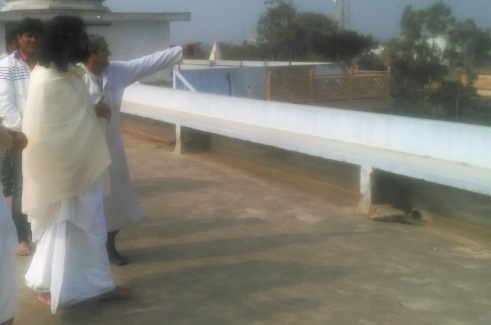
Soon after, he told Mohanji and our group about the dhyana mandir (meditation temple) in the dome on top of the terrace of the temple. He mentioned that this was restricted for the general public but he wanted Mohanji to follow him there and meditate in the dhyana mandir. He then proceeded to walk up to the terrace and requested us to follow him. He had recovered by then but there was a new spring in his step. We walked up the archaic spiraling staircase leading all the way up to the terrace of the temple building. As we walked up the stairs, he started telling us enthusiastically about the different aspects of the temple. The dhyana mandir was located inside a dome further up on the terrace with a series of steps leading up to it. He unlocked the dhyana mandir and let us in. He asked Mohanji and Guruji’s son to be seated at specific spots and stood in between them. We took our places and seated ourselves in a circle around the dome. He then started chanting Kabir’s dohas (poems) in a loud voice. It was almost like he was in a trance and the sound reverberated within the dome. He sung it with such pure emotion that we could all feel his bhaav (devotion). I was really touched by his pure devotion to Sant Kabir and his own Guru. I tried to meditate but found it much more soothing to watch him and feel the devotion ringing through his voice. I could feel so much love for him in my being. I just felt like hugging the old man. After he was done, he blessed both Mohanji and Guruji’s son.
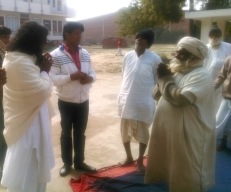
After taking his blessings, Mohanji and Guruji’s son headed out of the dhyaan mandir. While we were prostrating and taking his blessings, he kept saying, “Guru ka charan dho ke amrit piyo. Yehi rasta hai” (Wash the feet of the guru and drink the nectar. That’s the way) He said that for a long time he would wake up early in the morning and be the first one to literally do just that. If someone woke up before him and beat him to it, he would wake up one hour earlier than them to be the first to do it. That was the extent of his dedication and surrender. What bhakti and single-minded devotion to his Guru and his Guru’s mission. Ramana Maharishi said, “The Guru is pleased with him only who gives himself up entirely, who abandons his ego forever. Such a man is taken care of wherever he may be. He need not pray. God looks after him unasked”. Here was such a man!
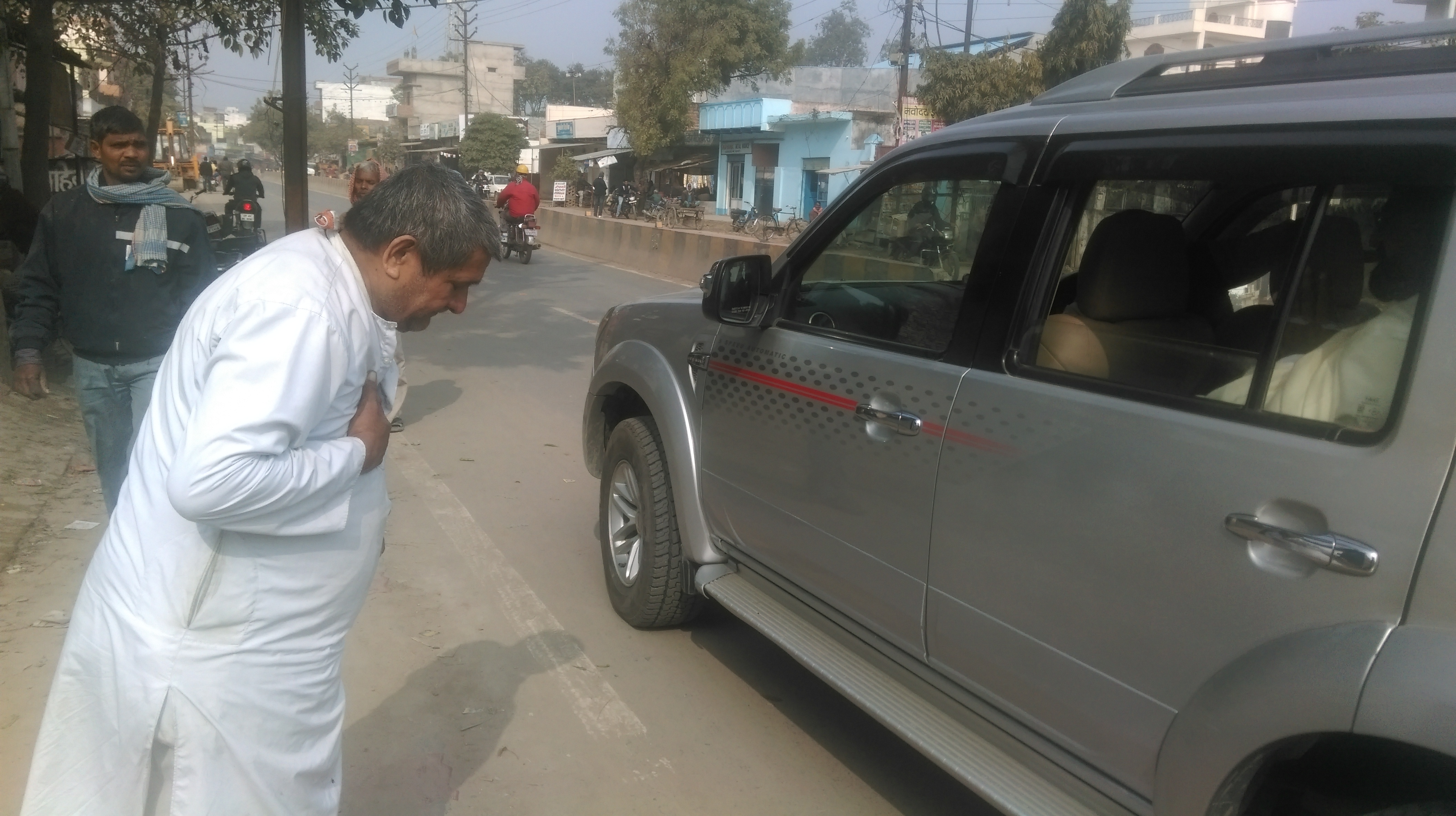
He then took us down to the basement that housed his Guru’s samadhi mandir. All of us prostrated there and offered our prayers. We then walked up to the main temple hall and decided to head out. He walked down all the way to the gates of the temple complex to drop Mohanji to the car. It felt like he didn’t want to leave Mohanji. Finally, when we were about to take his leave, he mentioned about the Kabir Math head office close by and offered to take Mohanji there. Mohanji agreed and requested him to get into our car. He directed the driver and led us to the Kabir Math head office. The office premises were much smaller in comparison. It opened into a ground that had a temple on one side towards the end with an ashram building opposite to the temple. There were several sadhus (mendicants) lazing about on the blankets spread on the ground or engaged in discussions. They greeted Mohanji and they engaged in a brief conversation enquiring about our whereabouts and providing us information on the purpose of their visit. We eventually walked down to the temple, offered our prayers there, bid goodbye to the sadhus and returned back to our car. We dropped the priest back to the Kabir Math in Lahartara. As we took leave of him, he bowed down to Mohanji and blessed all of us. He waited at the gates to see us off until we were out of sight. He was such a simple, sweet and devoted soul. Through Mohanji’s grace, all of us could cherish this beautiful experience. Guruji’s son also expressed that he had been to the Kabir Math several times but he had never encountered such a beautiful experience.

On the way back to the ashram, we headed to the main Buddhist temple at Sarnath. It is a touristy place with milling crowds admiring the beauty of the place and recording their presence in the place with cameras for posterity. We walked through the temple premises to the Mulgandha Kuti Vihar. The temple had beautiful murals on either side depicting different aspects of the Life of Buddha. As you walk towards the other end of the temple, you find a beautiful ornate golden statue of Lord Buddha seated on a throne. The intricate and vibrant artistry of the murals is truly remarkable and we tried to capture as much of it as possible in our cameras. Then we stepped out and walked to the Bodhi tree in the premises. It is not the original Bodhi tree from Bodh Gaya (under which Lord Buddha is purported to have been enlightened) but was planted by Buddha’s disciple, Anagarika Dharmapala, from a cutting of the original Bodhi Tree. The Bodhi tree is enclosed behind a gated enclosure and there are a few steps leading up to it. The origin and history of the tree is written on the gates. Mohanji walked up the steps and touched the tree as he closed his eyes. A divine communion – I guess. He allowed us to take some photographs of Him with the tree.
Finally, we went to see the depiction of the first sermon that Buddha delivered to his five disciples. The depiction has a statue of Buddha in the center with the statues of the five disciples seated around him in a circle. The statues are larger than life with lively colors. These five disciples were responsible for spreading Buddhism all over the world. When we were standing next to the statue, Mohanji remarked, “It took only five disciples to spread Buddhism across the world. Just think about it. Only five! That is the power of conviction”. That was a potent thought. The power of a disciple surrendered to the Guru’s will. Then nothing is impossible. I was tongue-tied and did not know how to respond except to mentally accept my failings as a disciple and strive to do better. We meandered over to the park to check out the huge bell near the banyan tree. However, it had a huge line of couples around it waiting to take souvenir photographs. So we ended our temple visit there and headed back to the guesthouse.
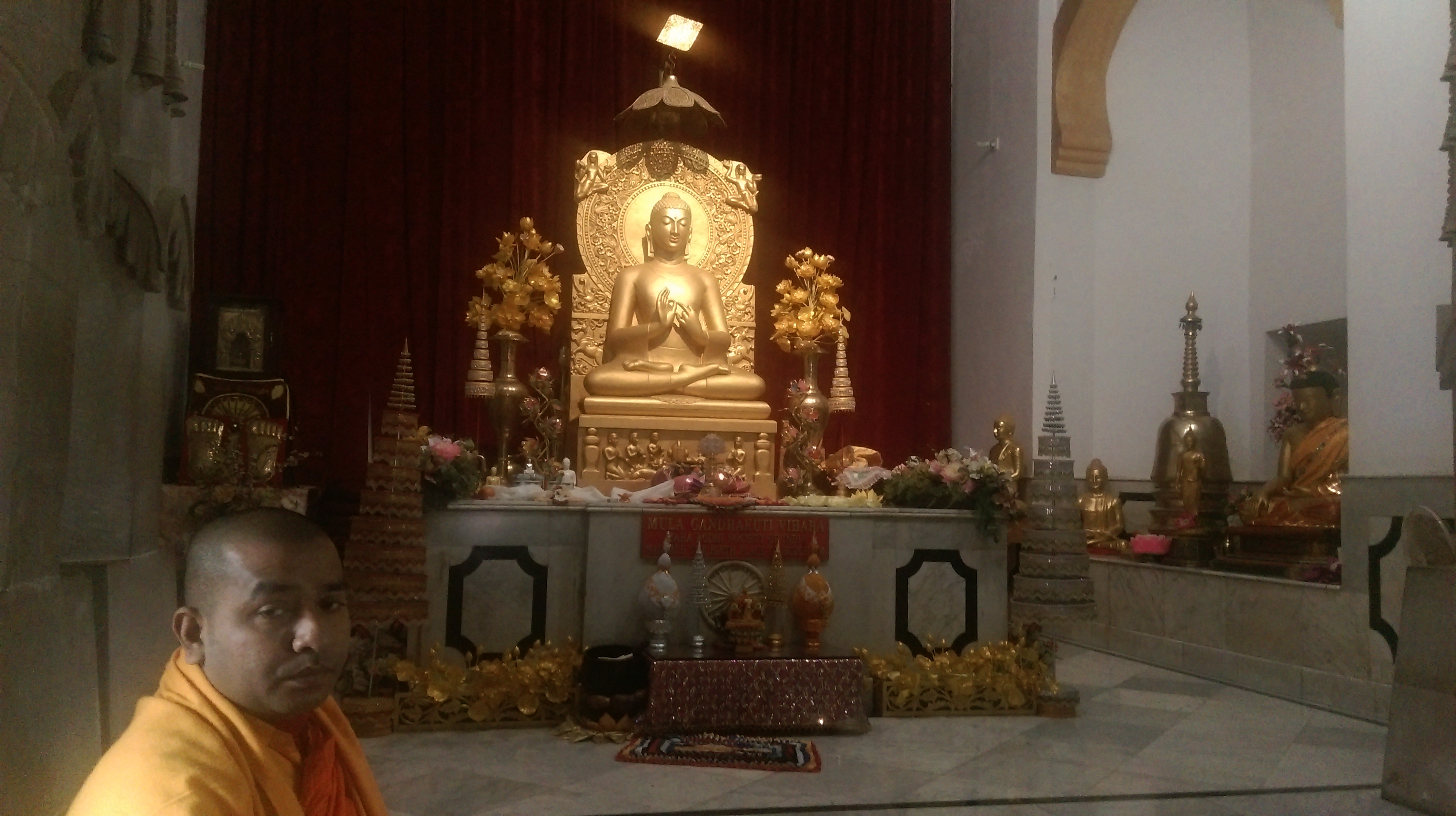
Late in the afternoon, Guruji himself came down to the ashram to inspect the arrangements and also to check on the work in the ashram. He supervised the food arrangements and the menu that was being served. He went to Mohanji’s room and said that the floor was too cold. He asked the staff to arrange for carpets on the floor from his private rooms. He also asked to get a new heater from his private rooms to be installed in Mohanji’s room. He had such an eye for detail that he even inspected the bathrooms to ensure that everything was perfectly in order for Mohanji.
We found out the reason for the reverence and respect accorded to Mohanji. The founder of their spiritual tradition had made notes in his diary about the divine incarnations for each age. Mohanji’s name was mentioned in the diary. He wrote this in the early 1900s long before Mohanji was even born!
In the evening, Guruji’s son and Mohanji had another meeting with Manik Jain. They were cloistered in the room as usual for a few hours. When it was time for dinner, we served them in Mohanji’s room. The next day we did not have any meetings planned. I found out that the driver of Guruji was an accomplished ayurvedic doctor with a clinic in Allahabad. Manikji highly recommended him for clearing system imbalances. I requested Mohanji to allow him to inspect and rectify any imbalances since Mohanji’s health had been oscillating the last few weeks. He diagnosed Mohanji and used massage techniques to rectify the problems. He proposed some general medicines for detoxifying the system and asked us to pick them up from the ashram dispensary. I also availed of his services. Post his treatment, I did feel lighter.
On the last day, Guruji himself came down to have dinner with Mohanji. He told Mohanji that you are like a member of my family. Manikji told us that he never shares his meals with anyone. In particular, he does not even take his meals with his own sons in keeping with the guru-disciple relationship. He said that this was a huge mark of respect accorded to Mohanji by Guruji. Guruji told Mohanji that he remembered that Mohanji loves mangoes. They were out of season at that time but he had specially picked up mangoes in Kolkata for Mohanji. He further told Mohanji that this was for him alone and he should not share these mangoes with anyone and eat them all by himself. As usual, it was just the two of them having a discussion and then their meals. The two masters showed a lot of love and respect for each other. Finally, Guruji left and retired to his room on the top floor.
The following morning, we got up early and packed our bags. Guruji and his son came to see us off to the cars. We said our goodbyes and particularly thanked Guruji for his unconditional love and generous hospitality. We also thanked the staff from the bottom for our hearts. Shastriji dropped us to the airport and we left for Bangalore from Benares.

4 thoughts on “Miraculous Days with Mohanji – Part IV”
Thank you for posting this miraculous experience.
You take us along with Guruji in His divine missions and journey dear brother. Not only we get darshan of maha purushas and holy places but through your narration we literally see them. Thank you is not sufficient but sending you pure love dear brother.
Thanks for sharing such a wonderful experience. Jai gurudev.
Pingback: Back from the dead – A tryst with Swami Samarth of Akkalkot | Experiences With Mohanji